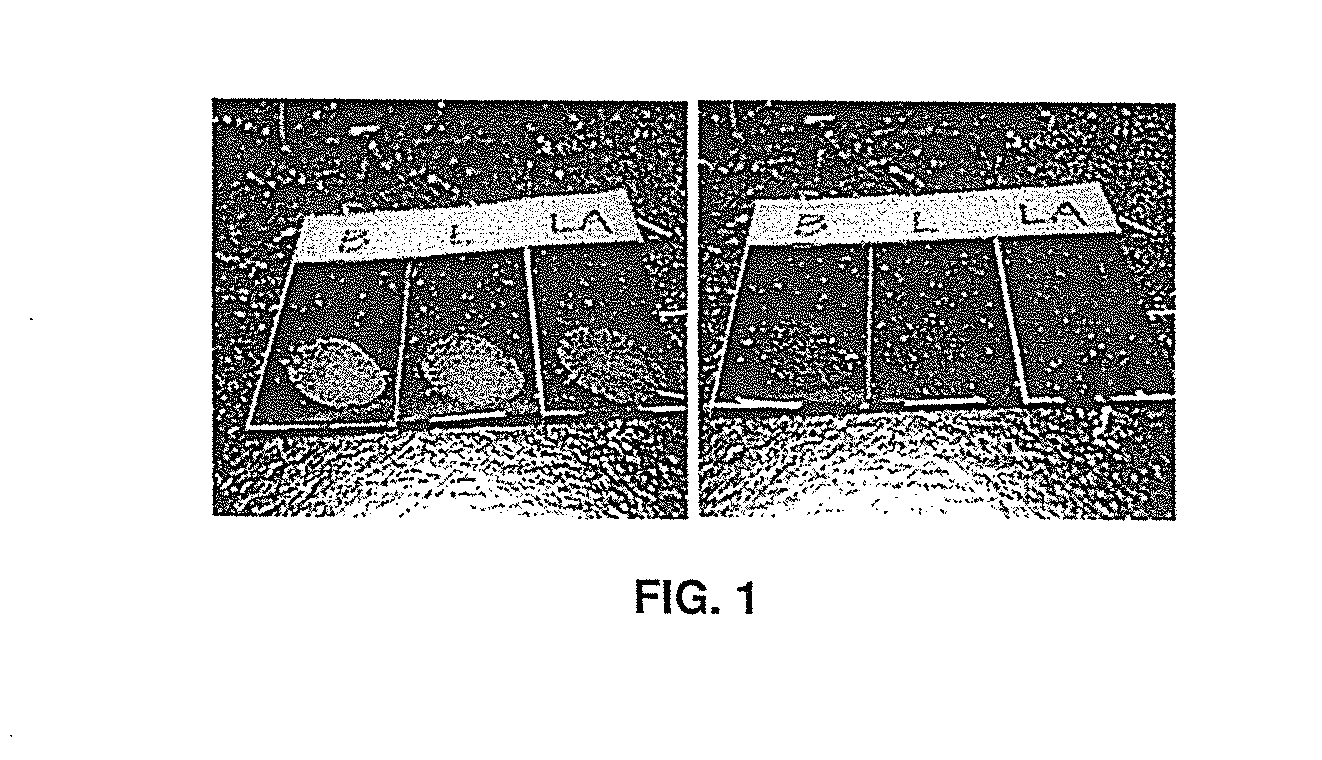Lipase-containing polymeric coatings for the facilitated removal of fingerprints
a technology of polymeric coatings and fingerprint removal, applied in the direction of enzyme stabilisation, enzymology, biochemistry apparatus and processes, etc., can solve the problems of fingerprint residue, unpleasant marks on the surface, deterioration of the cosmetic appearance of products, and needing water rinsing
- Summary
- Abstract
- Description
- Claims
- Application Information
AI Technical Summary
Benefits of technology
Problems solved by technology
Method used
Image
Examples
example 1
Production of Lipase Containing Material Operable for Coating a Substrate
[0068]Materials: Polyacrylate resin Desmophen A870 BA, and the hexamethylene diisocyanate (HDI) based polyfunctional aliphatic polyisocyanate resin Desmodur N 3600, the polyester resin Bayhydrol XP 7093, and Bayhydur 302 are obtained from Bayer Corp. (Pittsburgh, Pa.). The surfactant BYK-333 is obtained from BYK-Chemie (Wallingford, Conn.). α-Amylase KLEISTASE SD80 from. Bacillus subtilis (EC 3.2.1.1), lipase PS from Burkholderia cepacia, and Lipase AP12 from Aspergillus niger are obtained from Amano Enzyme Inc. (Nagoya, Japan). Butyl acetate, Bradford reagent, bovine serum albumin (BSA) from bovine serum, starch from potatoes, starch from wheat, maltose, sodium potassium tartrate, 3,5-dinitrosalicylic acid, Na2(PO4), NaCl, K2(PO4), casein, trichloroacetic acid, Folin & Ciocalteu's phenol reagent, Na2(CO3), sodium acetate, calcium acetate, tyrosine, p-nitrophenyl palmitate, ethanol, iodine, glucose, maltose, ma...
example 2
[0071]Fingerprint removal: The lipase containing coated panels of Example 1 are loaded with human fingerprints after touching the skin of the face or forearms. Fingerprinted panels are incubated at room temperature for at least 24 hours. A control panel is coated with the coating of Example 1 that is free of enzyme. After this first incubation period, the coated substrate is incubated in an oven at a temperature of 65° C. or higher for 1 to 6 hours.
[0072]FIG. 1 demonstrates that incubation of the enzyme coated panels at 65° C. for two hours facilitates complete removal of fingerprints. (B: control; L: lipase; LA: combined lipase and amylase in coating.)
example 3
[0073]The rate of fingerprint removal is faster in an enzyme containing substrate than control. FIG. 2 demonstrates aluminum plates coated with control or enzyme containing protein-polymer coatings as described in Example 1 where a fingerprint is loaded at the interface between the two coatings as described in Example 2. FIG. 2A demonstrates the remaining fingerprint after incubation at ambient temperature for 3 days. The plates are subsequently incubated for 2.5 hours at 65° C. and photographs are taken at various intervals as illustrated in FIG. 2B. FIG. 3 demonstrates that the increased rate of fingerprint removal is independent of the source of the fingerprints.
[0074]Various modifications of the present invention, in addition to those shown and described herein, will be apparent to those skilled in the art of the above description. Such modifications are also intended to fall within the scope of the appended claims.
[0075]It is appreciated that all reagents are obtainable by sour...
PUM
 Login to View More
Login to View More Abstract
Description
Claims
Application Information
 Login to View More
Login to View More - R&D
- Intellectual Property
- Life Sciences
- Materials
- Tech Scout
- Unparalleled Data Quality
- Higher Quality Content
- 60% Fewer Hallucinations
Browse by: Latest US Patents, China's latest patents, Technical Efficacy Thesaurus, Application Domain, Technology Topic, Popular Technical Reports.
© 2025 PatSnap. All rights reserved.Legal|Privacy policy|Modern Slavery Act Transparency Statement|Sitemap|About US| Contact US: help@patsnap.com



